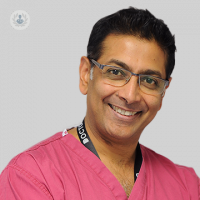Understanding EPSiT surgery: A minimally invasive approach
Written by:In his latest online article, Professor Tan Arulampalam gives us his insights into a minimally invasive EPSiT procedure (Endoscopic Pilonidal Sinus Treatment). He talks about lack of pain during surgery, enhancing recovery, advice after surgery, possible complications, challenges, minimising risks and exploring alternatives.

Pain after minimally invasive surgery
Looking into whether patients experience pain during EPSIT surgery brings up some interesting insights. Surprisingly, I recall my first patient, a carpenter, proudly sharing on social media that he hung doors just a day after the procedure. While I haven't undergone it myself, the patients I talk to generally have positive things to say – they're back on their feet quickly. Many even come from far away for the treatment.
Contrary to expectations, it seems the procedure isn't as painful as the traditional methods. Patients often manage to either drive themselves back home or are driven, which suggests the discomfort isn't significant.
Speedy recovery
The fact that patients recover quickly after inline surgery is worth looking into. Take the example of a patient hanging doors a day after the surgery – it challenges our ideas about recovery time. Research supports this trend: a review of several studies shows that most patients get back to work in less than a week. Dr Steve Wexner, a respected surgeon, also found that people were up and about within three days. This is in stark contrast to the longer recovery times associated with traditional surgery. This echoes my experience over the last 6 years.
Advice for after surgery
Giving patients the right guidance after surgery is crucial. I usually keep it simple. I tell them that the wound will be about the size of a five-pence coin – around 6 to 8 millimetres – if they're familiar with UK money. I suggest using breast pads, which are meant for women but work for anyone, to keep the area clean. After the first 10 days, flushing the wound with about 10 millilitres of saline is recommended. It's not complicated and doesn't require a nurse. Showering daily is important, and gently removing tissue from the wound's top layer helps prevent complications. About 10 to 14 days later, using manuka honey can promote healing. It's a simple regimen, but it works.
Possible complications
Surprisingly, there aren't many complications associated with EPSIT, both in my experience and generally. Occasionally, if the cauterisation is too intense on thin skin, some skin necrosis might occur. However, this is rare. Even looking at Dr Steve Wexner's and my own groups reviews, complications are quite low – usually in single-digit percentages.
Challenges of inline surgery
Moving from traditional surgery to inline surgery isn't without its challenges. It requires a change in how instruments are used, with a focus on wrist and finger control. It's a matter of ergonomics and finding a comfortable position. While it might take some getting used to, it's not unlike the way orthopaedic or trans anal surgeries have adapted to working in tight spaces.
Making sense of the images
Interpreting images during inline surgery can be tricky due to occasional fuzziness. It's not always easy to get a clear view. I tackle this by going into the surgical area, ensuring good fluid flow, and finding the right focus. It's a balance between clarity and pixelation. While it's a challenge, conversations with experts in the field show promise for better equipment in the future.
Minimising risks and exploring alternatives
Addressing the potential risks of cauterisation and damage to scopes is vital. Surgeon education is key – surgeons need to understand how to handle the tools properly. Making sure the cauterisation tool is visible and applying it carefully can help reduce risks. While lasers have their advantages, their cost and regulations make them less practical compared to cauterisation.
Safety concerns in a complex area
While EPSIT is generally safe, there are a couple of areas that need extra attention. For instance, going too close to the anal sphincters can lead to complications. Proper training and care can help prevent any issues in these scenarios.
Training and business considerations
Proper training is crucial before attempting inline surgery. It involves understanding the equipment, patient setup, and practical skills. A comprehensive training program with online modules, hands-on sessions, and simulations is important. From a business standpoint, understanding the costs, patient numbers, and potential benefits is essential. Looking at how the service can be expanded to help more patients is also worth considering.
EPSIT brings a new dimension to surgical interventions, offering faster recovery and patient-friendly outcomes. Through practical insights into techniques, training, and business aspects, this innovation shows great promise. As medical advancements continue, the potential for better patient experiences and outcomes becomes more attainable.
Professor Tan Arulampalam is a distinguished general surgeon with over 20 years of experience. You can schedule an appointment with Professor Arulampalam on his Top Doctors profile.


